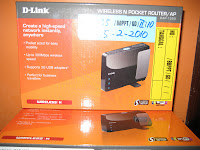 In March 17Th 2010 in Indonesia Wireless N Pocket/Ap DAP-1350 and Mobile wireless Router DIR-412 telecommunication devices D-Link, has been issued type approvacertification by DGPT March 15Th 2010.
In March 17Th 2010 in Indonesia Wireless N Pocket/Ap DAP-1350 and Mobile wireless Router DIR-412 telecommunication devices D-Link, has been issued type approvacertification by DGPT March 15Th 2010.Create a wireless network by connecting the DAP-1350 to an Internet connecting whether via Ethernet cable or 3g USB Adapter to enjoy wireless to connectivity for multiple PC's we you are out on the road in places like conference rooms or hotel rooms.
You can connect a 3G USB adapter to share your 3G Internet connection on the road, enabling you to provide multiple PC's with instant connectivity.
Contents of packaging :
- Wireless N Pocket Router/AP DAP-1350
- Ethernet cable - CAT5
- Power Adapter 5v 2.5A
- USB power cable
- Travel case
- CD ROM includes technical manual
Product setup : Easy setup : AP Mode
- Switch to AP ( access point ) Mode : Move the move switch on the DAP-1350 to the AP position. In this mode, the DAP-1350 will function as an access point.
- Connect to a router : Use the included Ethernet cable to connect the DAP-1350 to an available LAN port on your router. Make sure DHCP on your router is enabled. Connect the power adapter to the DAP-1350. Wait until the power LED changes from red to blue.
- Connect to the DAP-1350 : Use a PC with wireless adapter enabled wireless networks. Connect to the network with D-Link as the SSID
- Configure the DAP-1350 : Open a web browser and go to http://dlinkap. Enter admin as the user name adn leave the password blank. Now you can use the setup Wizard to configure your DAP-1350.
Product setup : Easy setup : Client Mode
- Swich to CL Mode : Move the move swich on the DAP-1350 to CL position. In this mode, the DAP-1350 will function as a wireless client.
- Connect to your PC : Use the Ethernet cable to connect the DAP-1350 to your desktop or laptop PC. Connect the power adapter to the DAP-1350. wait until the power LED changes from red to blue.
- Configure the DAP-1350 : Open a web browes and go to http;//dinkap. Enter admin as the User Name and leave the password blank. Now you can use the setup Wizard to configure your DAP-1350.
- Connect wireless : After completing the setup Wizard, you can connect to a wireless network.
Product setup : Easy setup : Router Mode
- Switch to RT Mode : Move the move to the RT position. In this mode, the DAP-1350 will function as a router
- Connect to your Modem : Use the included Ethernet to connect the DAP-1350 to the LAN port on your modem. Connect the power to the DAP-1350. Wait until the Power LED changes from red to blue.
- Connect to the DAP-1350 : Use a PC with a wireless adapter enable to open a web browser and Scan for available wireless networks. Connect to the network with dlink as the SSID
- Configure the DAP-1350 : Open a web browser and go to http://dlinkap. Enter admin as the user name leave the password blank. Now you can use the setup Wizard to configure your DAP-1350.
Technical specification Wireless N Pocket Router/access point DAP-1350 :
Standard
- IEEE 802.11b
- IEEE 802.11g
- IEEE 802.11n 2.4GHz
- IEEE 802.3u
Interface type
- Mode selection switch ( Router/Access point/Client )
- 10/100 WAN/LAN Port
- USB Port foe 3G adapter' and Share Port
- WPS Button
- Reset button
operating Frequencies
- 2.4 to 2.4835 GHz
Operating Channels
- FCC 11
- ETSI:13
Operating Modes
- Router mode
- Access Point Mode
- Wireless Client Mode
Antenna Type
- 2 Integrated Antennas
Security
- 64/128-bit WEP
- Wi-Fi Protected Access ( WPA-PSK, WPA2-PSK )
- Wi-Fi Protected Setup ( WPS PIN/PBC )
- MAC Address Fettering
- Disable SSID Broadcast function
LED
- Power
- Lan
- WLAN
Certification
- FCC Class B
- CE
- C-Tick
- Wi-Fi, PS/Wi-Fi Protected setup
- IC
Quality of service
- Wi-Fi Multimedia ( WMM )
Dimensions
- 91mm x 65mm x 21mm ( 3.58in x 2.56in x 0.85in )
Weight
- 64 grams
Storage temperature
- 10 to 70 C ( 14 to 158 F )
Storage humidity
- 5% to 95% non-condensing
No comments:
Post a Comment